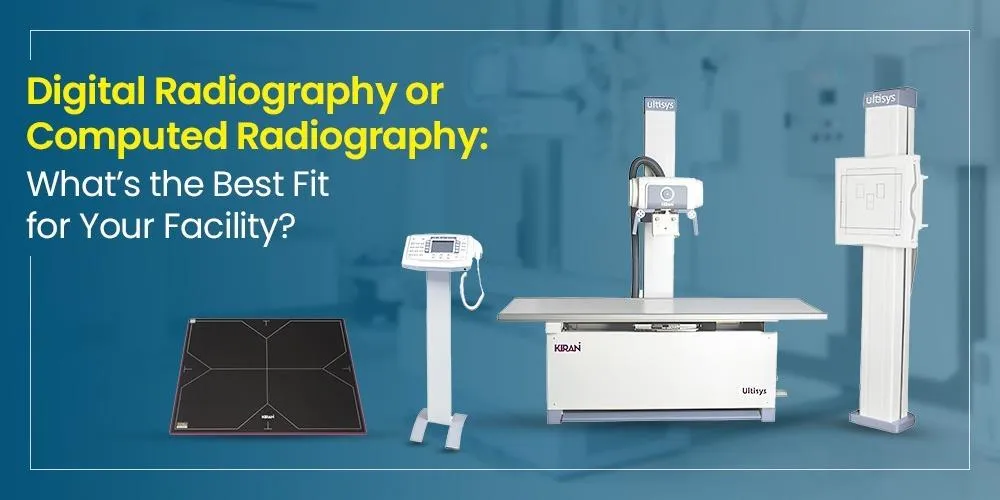In the modern medical world, light plays a significant role in identifying the ailment inside the body. Of everything, light not only illuminates the path but also helps us take a clear and concise look into – a place that couldn’t be seen with the naked eye. Radiography employs light as its primary component; without ‘light’ most diagnostic procedures won’t see the ‘light’. Before shedding more light on this, let us know about the two prominent types of radiography – Digital and Computed.
Understanding the Light Bearers
Both Digital Radiography (DR) and Computed Radiography (CR) serve as modern alternatives to traditional film-based X-ray imaging. While both technologies capture the essence of radiographic imaging, they differ in their approach to converting X-ray energy into diagnostic images. Think of them as two different artists painting the same scene – both are illustrious, but their techniques and tools vary significantly.
Digital Radiography – The Instant Messenger
Like the speed of light itself, DR systems offer nearly instantaneous image acquisition. The digital radiography machine converts X-ray exposure directly into digital signals through specialized detectors, much like how modern digital cameras capture light. This direct conversion eliminates the intermediate steps, offering healthcare providers immediate access to high-quality diagnostic images.
The immediate image preview, similar to a photographer’s digital display, allows technologists to assess image quality instantly. This rapid feedback loop ensures optimal patient positioning and exposure parameters, reducing the need for repeat exposures and, consequently, radiation dose to the patient.
Computed Radiography – The Trusted Messenger
Computed radiography machines serve as a bridge between traditional film-based radiography and the digital age. Using phosphor plates that store X-ray energy – much like how solar panels store sunlight – CR systems require an additional step of plate reading. These imaging plates, though similar in size and handling to traditional X-ray films, hold the invisible image until processed through a dedicated reader.
Key Differentiators – Making an Informed Choice
Workflow Efficiency
Digital Radiography systems shine brightest in high-volume facilities where time is of the essence. With instant image acquisition and processing, digital radiography equipment can significantly reduce patient waiting times and increase throughput. Computed Radiography, while slower in comparison, offers reliable performance with a more modest initial investment, making it suitable for facilities with lower patient volumes.
Image Quality and Dose Efficiency
Both technologies produce diagnostic-quality images, but Digital Radiography systems generally offer superior detail visibility and contrast resolution. Like a high-resolution camera that captures the finest details, these systems can operate with lower radiation doses while maintaining excellent image quality. Computed Radiography systems, though highly capable, might require slightly higher exposure factors to achieve similar quality results.
Investment Considerations
Choosing between Digital and Computed often resembles deciding between buying a high-end vehicle outright or leasing a reliable car. While digital radiography machine prices are typically higher upfront, they offer long-term benefits in workflow efficiency and reduced operating costs. Computed radiography machine systems present a more modest initial investment, making them an attractive option for smaller facilities or those transitioning from analog to digital imaging.
Facility-Specific Factors to Consider
Space and Infrastructure
Digital radiography equipment typically requires less physical space, eliminating the need for plate readers and storage areas. However, they may need a more robust IT infrastructure to handle larger data volumes. Computed Radiography systems, with their separate reading stations, require dedicated space but can operate with simpler network setups.
Patient Volume and Type
Emergency departments and high-throughput imaging centers might find Digital systems’ speed invaluable. However, smaller clinics or specialized facilities might better utilize CR’s flexibility and lower initial costs. Consider your facility’s patient flow patterns and typical examination types when making this choice. If you are caught between the two worlds, remember it is always good to go for the smaller ones before allowing them to grow bigger.
Future Growth and Adaptability
Like planting a tree, choosing an imaging system requires foresight. Digital Radiography systems often offer easier upgrades and integration with emerging technologies. Computed Radiography systems, while more limited in upgrade potential, provide stable, reliable performance with lower maintenance requirements.
Making the Right Choice
The decision between Digital and Computed requires careful consideration of multiple factors. When evaluating radiography machine prices, consider your facility’s unique needs, budget constraints, and future growth plans. Both computed radiography machines and digital radiography systems serve as proven technologies in modern medical imaging – the key lies in matching the right technology to your specific requirements.

